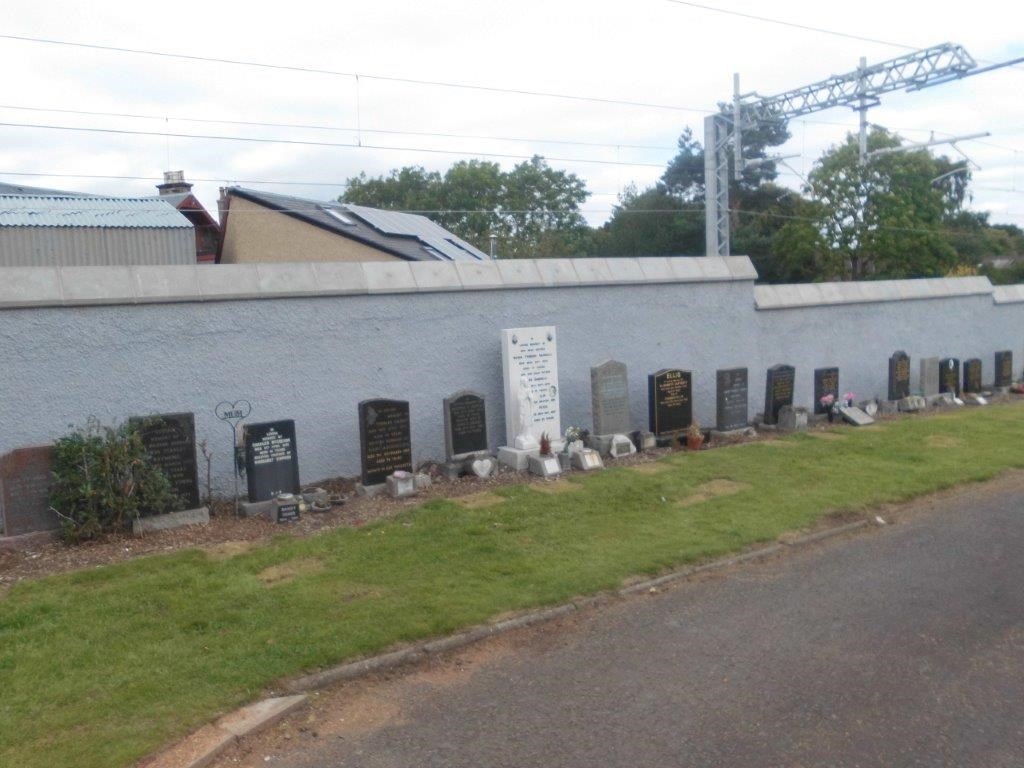Tuesday 29 Aug 2017
Edinburgh-Glasgow boundary works complete
- Region & Route:
- Scotland’s Railway: Scotland
Network Rail has completed a programme of work between Edinburgh and Glasgow to secure the railway boundary and make it compliant with new safety standards ahead of the electrification of the line.
Completion of the Linlithgow cemetery boundary wall marks the end of a route wide, £3.3m investment on the main Glasgow–Edinburgh, via Falkirk High, line – which included replacing or increasing the height of 15km of walls and fencing to comply with the 1.8 metre safety standard for an electrified railway.
The cemetery wall at Linlithgow presented one of the more challenging aspects of this part of the work, given the sensitivities of the location and that scaffolding had to be erected over a number of graves bordering the boundary wall.
Spanning some 110m in length, the wall was raised by between 100 millimetres and 600 millimetres by removing the existing coping stones, rebuilding the wall and replacing the copes.
The work has been completed ahead of the energisation for testing of the line which is scheduled for Saturday, September 2.
Kevin McClelland, route delivery director for Infrastructure projects said: “Electrification marks a significant change to the railway environment in terms of risk for those living or working near to the newly electrified routes so it is important we do what we can to keep people safe.
“Linlithgow Cemetery represents the last section of our boundary work to be completed ahead of the electrification of the line as part of the Edinburgh Glasgow Improvement Programme (EGIP). From the outset, we were aware that working in this location had added considerations and so we worked closely with West Lothian Council’s cemeteries manager throughout to ensure that work was as unobtrusive as possible.
“With the route wide boundary works now complete, the 1.8m height walls and fences will help protect the public from the overhead power lines carrying 25,000 volts of electricity – enough to kill anyone who comes into contact with them.”
EGIP is a Scottish Government-funded investment to deliver a rolling programme of electrification across the central belt to enable faster, greener and more energy efficient electric trains to be introduced.
In addition to the 15km of boundary enhancements, 60 bridges have been replaced and the parapet heights at more than 100 bridges have been raised.
To date, EGIP has successfully completed the £80m electrification of the Cumbernauld line, the £25m redevelopment of Edinburgh’s Haymarket station and the completion of the new, £41m Edinburgh Gateway train-tram interchange.
Notes to Editors
Work at Linlithgow cemetery took place between July and August 2017.
The team undertaking the task carefully erected the scaffolding to make certain it did not sit on any of the existing plots. Where necessary, the scaffolding bays were adjusted to suit the position of the graves.
Care and attention was also undertaken to cover 97 gravestones in protective wrapping for the duration of the works.
Once the existing copes were removed from the top of the wall, the team built up each section until it reached the required height. The wall was then rendered and new scopes installed.
The main Edinburgh-Glasgow via Falkirk High railway line will be energised for testing on Saturday, September 2.
Energisation is an important phase of work to test and validate the new equipment and ensure it is operating as it should. As well as ‘live testing’ the equipment, the energisation phase of work is critical to ensuring the safe introduction of the electric trains that will operate on the route.
Contact information
Passengers / community members
Network Rail national helpline
03457 11 41 41
Latest travel advice
Please visit National Rail Enquiries
Journalists
Network Rail press office - Owen Campbell
NR Press Office 0141 555 4108 / 07515 617073
Owen.Campbell1@networkrail.co.uk
About Network Rail
We own, operate and develop Britain's railway infrastructure; that's 20,000 miles of track, 30,000 bridges, tunnels and viaducts and the thousands of signals, level crossings and stations. We run 20 of the UK's largest stations while all the others, over 2,500, are run by the country's train operating companies.
Usually, there are almost five million journeys made in the UK and over 600 freight trains run on the network. People depend on Britain's railway for their daily commute, to visit friends and loved ones and to get them home safe every day. Our role is to deliver a safe and reliable railway, so we carefully manage and deliver thousands of projects every year that form part of the multi-billion pound Railway Upgrade Plan, to grow and expand the nation's railway network to respond to the tremendous growth and demand the railway has experienced - a doubling of passenger journeys over the past 20 years.
Follow us on Twitter: @networkrail
Visit our online newsroom: www.networkrailmediacentre.co.uk

